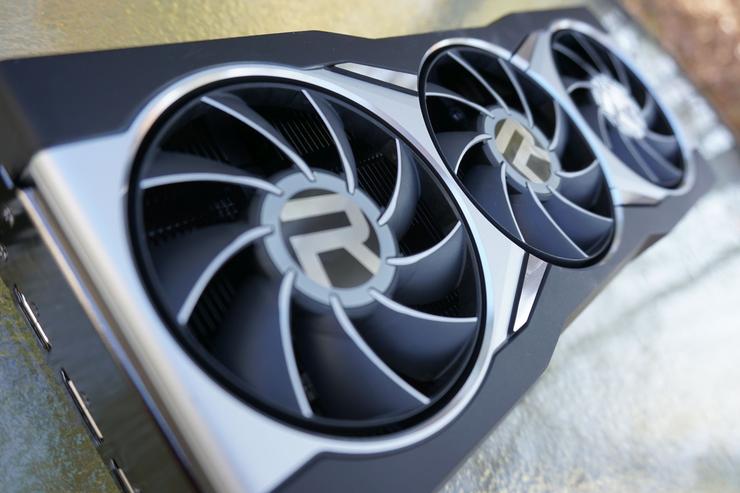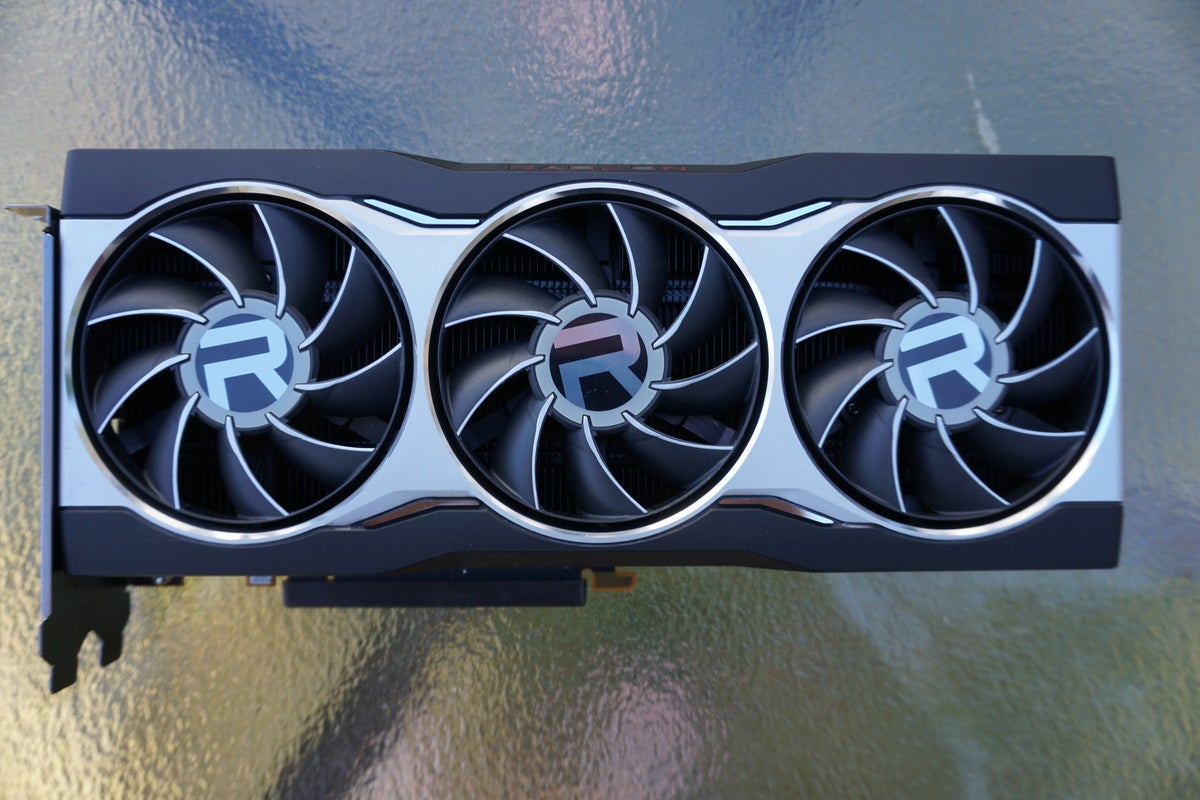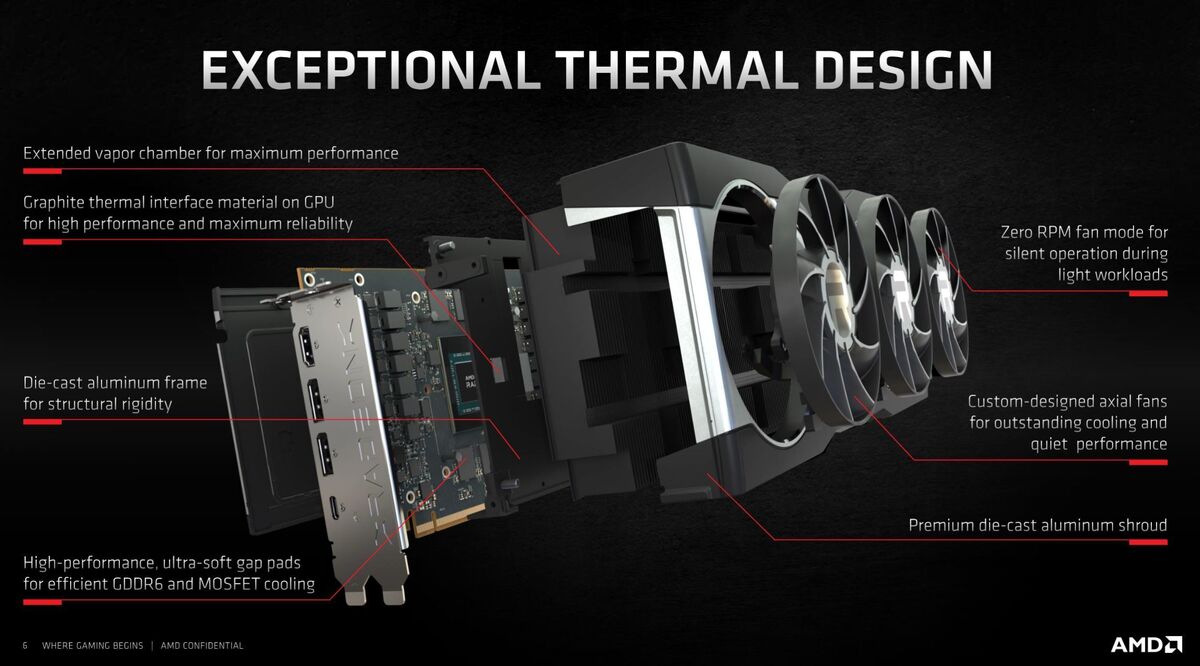 Credit: Brad Chacos/IDG
Credit: Brad Chacos/IDG
Radeon RX 6800 and 6800 XT physical design
The Radeon RX 6000-series also marks a new era for the outside of AMD graphics cards.
 Brad Chacos/IDG
Brad Chacos/IDGFor years, both AMD and Nvidia offered reference designs of their cards that used blower-style cooling. As detailed in our reference vs. custom card explainer, blower cards are good for small or cooling-constrained systems, because they blow the hot air fully out of your system rather than routing it through your case. The downside? Blower-style coolers tend to run hotter and louder than graphics cards with axial fans, and AMD’s past reference designs were notorious examples of those traits. (I hate just being in the room with a reference Vega 64 or 290X.)
Nvidia switched to axial cooling for its Founders Edition reference models with the RTX 20-series and immediately achieved much better cooling. This disparity made AMD’s blower-style cooling on the last-gen Radeon RX 5700 and 5700 XT stick out even more. With the Radeon RX 6000-series, AMD is ditching blower-style coolers, too.
 Brad Chacos/IDG
Brad Chacos/IDGAMD outfitted its new graphics cards with a premium, all-metal cooler with a trio of axial fans, complete with a sleek silver backplate and an illuminated Radeon logo. We covered the new design in depth in our unboxing of the Radeon RX 6800 and 6800 XT.
They look like standard (yet swanky) high-end graphics cards, frankly, and AMD claims that was a goal. While Nvidia’s GeForce RTX 30-series Founders Edition cards pack radical (and effective) “flow-through” push-pull coolers and a proprietary 12-pin connector, the Radeon cards stick to established norms, from their 10.5-inch length to their dual 8-pin power connectors.
Do note that the Radeon RX 6800 XT measures 2.5 slots thick, however. That’s not unusual for an enthusiast-class graphics card—virtually all custom RTX 3080s and last-gen 2080 Ti cards were three slots as well—but it means the GPU might not fit in particularly snug cases.
 Brad Chacos/IDG
Brad Chacos/IDG
Standard 8-pin connectors.
As you’ll see in our benchmarks later, this new design is a massive step up over the blower coolers of yesteryear. It’s significantly quieter and keeps the GPU much chillier. That’s especially good news becausee today’s launch will be limited to this reference design alone. Custom boards are scheduled to hit the streets November 25.
 AMD
AMDBeyond the aluminum shroud, the trio of 90mm fans on the Radeon RX 6800 and 6800 XT include a zero-rpm fan mode. That means they turn on only when the GPU is stressed, so the cards stay silent when you’re web-browsing and doing other light work. AMD also used a graphite thermal material instead of the thermal paste you’d normally find between the GPU die and the heat sink; the company says it won’t degrade over time like traditional paste does.
 AMD
AMDAMD used a 14-layer PCB built from “premium” IT-170 material to ensure reliable signal integrity given the GPU’s sky-high clock speeds, and it equipped the Radeon RX 6800-series GPUs with 15 high-efficiency power phases. The power phases paired to the GDDR6 memory aren’t as robust as what you'll see on competing boards, but that’s not a bad thing. Once again, Infinity Cache is the reason.
 AMD
AMD“Because we can store more information on-die, there are fewer required memory transactions,” AMD Fellow Laura Smith said in a briefing for reporters. “We also selected dual-density GDDR6 memory. The combination of these two choices allow us to deliver performance with only two phases for each of the eight memory devices. Leveraging the Infinity Cache, and this thoughtful design point, we can give lots of headroom for overclocking with an efficient board layout.”
 Brad Chacos/IDG
Brad Chacos/IDG AMD
AMD
Encode and decode supported on the Radeon RX 6000-series GPUs.
On the rear of the card you’ll find dual Displayports, a USB-C port that can be used with displays and compatible VR headsets alike, and a single HDMI 2.1 connection with variable refresh rate support. By comparison, Nvidia omitted a USB-C port from its RTX 30-series cards after including it on the 20-series, claiming that it wasn’t used much. AMD’s upgrade to HDMI 2.1 means you can drive a 60Hz 8K display or a speedy 144Hz 4K monitor with a single cable, a feature that pairs nicely with RDNA 2’s newfound AV1 decode support, which enables stutter-free streaming of 8K videos.
Next page: Smart Access Memory

















